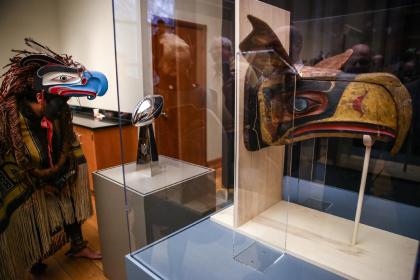Inspiration for Seahawks logo visits Seattle with assist from Patriots fan
For years, the mask that inspired Seattle's beloved NFL team logo sat thousands of miles away. At one point during renovation, it was even placed in storage.
Gretchen Faulkner, director of the University of Maine's Hudson Museum, liked to show it off, leading guests away from the main halls and pointing it out. She called it "the Seahawks mask."

But people didn't really care.
"I wouldn't get much response," Faulkner says. "People were Patriot fans, so they were like, 'Yeah, sure.' "
She couldn't blame them; she was a Pats fan too.
It's possible that if not for this Pats fan and her staff, the gorgeous work of art that launched the Seahawks logo many years ago might still be in Maine, unbeknownst to the football fans who now come to see it. Instead, two curators from rival regions worked together to complete a mask's journey home from, of all places, Arizona – where the Seattle Seahawks will meet the New England Patriots in Super Bowl XLIX in Glendale on Feb. 1.
The tie between the Seattle area and the Native population has always been strong – "Seattle" is from a Duwamish Indian leader named Sealth – and the logo of the NFL team reflects that. The designers of the logo likely got inspiration from art books devoted to the style of the Pacific Northwest, which in turn was based on the totem poles that became popular with shippers stopping through on their way to British Columbia and Alaska in the late 1800s.

Specifically, it's believed the Seahawks logo is derived from a photo in a 1950 book, "Art of the Northwest Coast Indians." That photo depicts a "transformation mask" of an eagle (or "thunderbird"), which opens up to reveal a human face. The mask is from the Kwakwaka'wakw nation, but it's not known exactly which family.
"The general idea is our ancestors first came down wearing animal costumes," says Andy Everson, a British Columbia-based artist from the Kwakwaka'wakw nation. "They would fly around and at one point they took off their animal costumes and became human. It was a dynamic way of portraying these stories. Imagine doing the stories by firelight, it's pretty magical."
The Seahawks logo is unique in this way because it is painted on the outside of the helmet, and the human is revealed through the facemask. Every play in every game is, in a way, a tribute to Native heritage.
"There are certain teams in the league that can use better relations with Native people," Everson says. "I won't mention names."
But for many years, it was unknown where the original inspiration for the Seahawks logo was actually located.
According to Faulkner, the mask spent years in Arizona, in the possession of famous German artist Max Ernst. After he died in 1976, the mask was obtained by William Palmer, a noted alum of Maine. It was Palmer who bequeathed the mask to the Hudson Museum. For the better part of two decades, starting in 1982, it was displayed there, given catalogue number HM5521.
But Faulkner says it was displayed in its transformative mode, with the human face showing. The "Seahawks mode," with the thunderbird facing out, was obscured. Eventually, when the museum was renovated five years ago, the mask went into temporary storage.
It might have never left Maine if it wasn't for an enterprising class at the Burke Museum in Seattle.
"Students were looking at Northwest coast art and they Googled ‘Seahawk logo,'" says Robin Wright, who is a curator of Native art at the museum. "That inspired me to actually find the mask."
She enlisted the help of a former museum curator and leading expert in Native art, Bill Holm. Last year, Wright wrote a blog post for the museum on the meaning of the mask, and published a photo of what was thought to be the original.
"The sweep of the bold painted line around the front of the eye socket and back of the mouth, the open-ended eyelid lines, and the line of the mouth and beak all match nicely with the original Seattle Seahawks logo," Wright wrote. "The origin of this mask is halfway between Alaska and Seattle on the northeast side of Vancouver Island."
Faulkner saw the blog, and had her Eureka moment: finally a connection to the mask's roots. So the Pats fan reached out to the Seahawks fan.
"They were just amazed where it had gone," Faulkner says.

The two worked out an arrangement: the mask would be loaned to the Burke Museum from late 2014 until July 2015. Money for the transfer was raised through a Kickstarter campaign. The Burke decided to have a celebration for the mask in mid-November, which included the Seahawks cheerleaders, a speech by former quarterback Jim Zorn, and a ceremonial dance from Everson.
The event was a hit, drawing fans and the idly curious to see a 2-foot-long mask that had tinges of red and yellow, mirrors for eyes, and a design that looked just like the early team logo. It had a tag dating from 1910. The curators at the Burke Museum set up the mask next to the Lombardi Trophy and a blessing was given. Zorn called it a "wonderful cultural exchange."
It may have also been more than that. At the time of the event, the Seahawks were coming off a 24-20 loss to the mediocre Kansas City Chiefs, dropping them to 6-4 for the season.
Since the unveiling, and the blessing, the team is 8-0 and in another Super Bowl.
